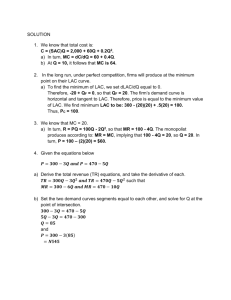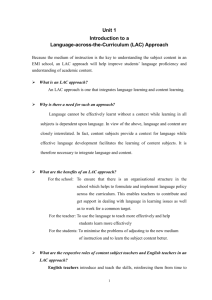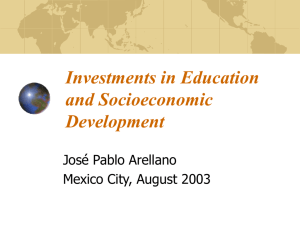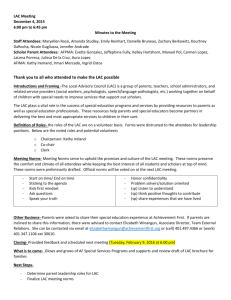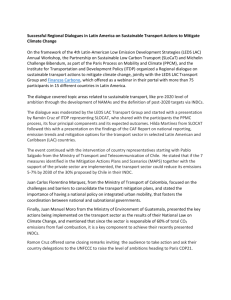Monetary Policy with Head Winds: Issues and Trade-offs
advertisement
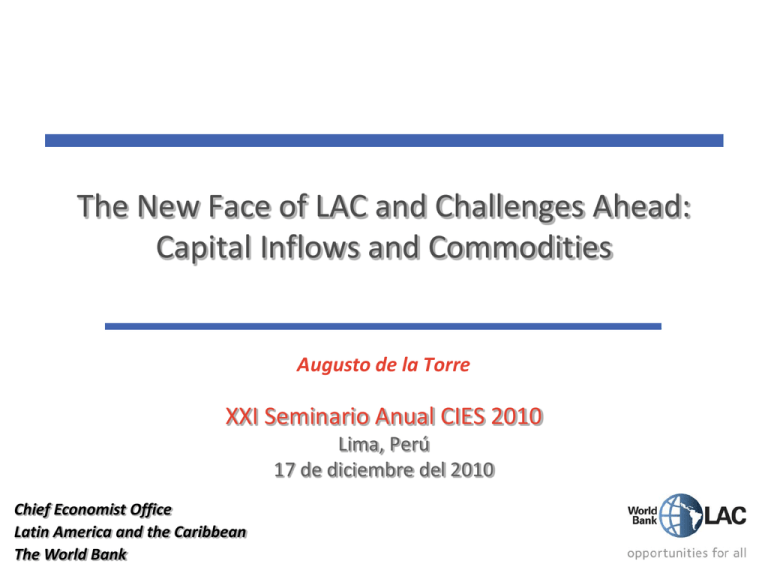
The New Face of LAC and Challenges Ahead: Capital Inflows and Commodities Augusto de la Torre XXI Seminario Anual CIES 2010 Lima, Perú 17 de diciembre del 2010 Chief Economist Office Latin America and the Caribbean The World Bank 1 Agenda LAC breaking with the past: financially globalized yet resilient Resilience through the cycle Driving forces of resilience and performance Policy-related and exogenous Policy challenges Dealing with frothy capital inflows Harnessing benefits/avoiding risks of natural resource abundance 2 LAC breaking with the past: financially globalized yet resilient 3 Defining and measuring resilience Definition – resilience is the ability to: Withstand the initial external shock Engineer a fast and strong recovery Conduct counter-cyclical policies in bad and good times Measurement – indirectly, through an outcome variable (GDP) that actually reflects a combination of factors … Size of the shock Degree of exposure to the shock Extent of resilience per se (“relative” resilience) … which we sort out through econometric techniques and using appropriate comparators 4 Exposure to the shock: degree of financial globalization Financial Openess (Flows) Simple Averages 20 18 Percentage of GDP 16 14 12 10 8 6 4 2 0 Other South Am. Countries Central Am. + Dom. Rep. Caribbean LAC-6 + URY Note: Financial openness is the amount of inflows and outflows of capital as a percentage of GDP. In this graph, Central America excludes Panama (an outlier due to its condition as offshore financial center). Source: IMF’s BOP 5 Exposure to the shock: degree of trade openness Trade Openness Simple Average 120 Percentage of GDP 100 80 60 40 20 0 LAC-6 + URY Other South Am. Countries Central Am. + Dom. Rep. Note: Trade openness is the sum of exports and imports as a percentage of GDP. Source: IMF’s WDI Caribbean 6 Resilience: benchmarking LAC through the cycle Resilience in the downturn: not worse than the Asian Tigers Downturn was highly synchronized around the globe LAC was not immune, but its growth collapse (6.5 pp) was comparable to that of the East Asian Tigers and significantly smaller than that of ECA (13 pp) Within LAC, the collapse was largest where trade openness is highest – the Caribbean (8.7 pp) -- and smallest in the less financially globalized countries of South America (6.2 pp) Resilience in the rebound: fast and strong growth recovery LAC’s recession was shorter compared to previous crises and the MIC average Brazil led the LAC pack: industrial production started to recover in 3 months! Strong recovery: like other non-ECA MICs, LAC’s GDP in 2010 will be above its 2008 level (ECA: 1.7% below; HICs: 0.2% below) LAC’s GDP will be closer to potential than the East Asian Tigers (who have higher potential) Brazil, Peru, Argentina, Uruguay, Panama, and Dominican Republic lead the LAC pack 7 2009 growth collapse: LAC no worse than the East Asian Tigers, but particularly bad for the Caribbean GDP Growth Collapses Across LAC Countries GDP Growth Collapses Across Regions 0% 0% -2% Percentage Points Percentage Points -2% -4% -6% -8% -10% -4% -6% -8% -10% -12% -14% -12% -16% -14% South Africa HIC East Asian Tigers LAC China Ant & Barb Grenada Venezuela Paraguay Mexico Panama Costa Rica Trin & Tob Honduras Peru El Salvador Argentina LAC Brazil Chile Guatemala Colombia Dom Rep Uruguay Nicaragua Jamaica Guyana Dominica Suriname Ecuador Belize Bolivia -18% ECA India GDP Growth Collapses Within LAC Regions -5.0% -5.5% Percentage Points -6.0% -6.5% -7.0% -7.5% -8.0% -8.5% -9.0% Caribbean Central Am. + Dom. Rep. LAC-6 + URY Other South Am. Countries Notes: Growth collapses are defined as growth in 2009 minus growth in 2007. Country groupings are simple averages. Haiti is not included among Caribbean countries. Source: IMF's WEO (October 2010) 8 Resilience: benchmarking LAC through the cycle Resilience in the downturn: not worse than the Asian Tigers Downturn was highly synchronized around the globe LAC was not immune, but its growth collapse (6.5 pp) was comparable to that of the East Asian Tigers and significantly smaller than that of ECA (13 pp) Within LAC, the collapse was largest where trade openness is highest – the Caribbean (8.7 pp) -- and smallest in the less financially globalized countries of South America (6.2 pp) Resilience in the rebound: fast and strong growth recovery LAC’s recession was shorter compared to previous crises and the MIC average Brazil led the LAC pack: industrial production started to recover in 3 months! Strong recovery: like other non-ECA MICs, LAC’s GDP in 2010 will be above its 2008 level (ECA: 1.7% below; HICs: 0.2% below) LAC’s GDP will be closer to potential than the East Asian Tigers (who have higher potential) Best performers are the financially globalized commodity exporters like BRA, PER, and URU 9 Size and duration of downturn: LAC better than its past and ahead of the MIC average Cyclical Growth Dynamics in a Comparative Setting Historic cycle Current cycle Historic cycle Current cycle -3.5 Notes: In the figures, period T stands for the Peak year in GDP business cycles. The sample of LAC countries includes: Argentina, Brazil, Chile, Colombia, Costa Rica, Ecuador, Mexico, Peru, and Venezuela. Sources: Calderón and Servén (2010), EIU, Haver Analytics, LAC Central Banks and Statistical Offices. 10 T+8 T+6 T+4 T+2 -4.5 T-8 T-6 T-4 T-2 T T+2 T+4 T+6 T+8 T+8 T+6 T+4 T+2 T T-2 T-4 -4.5 T-6 -4.5 -3.5 -2.5 T Historic cycle Current cycle -3.5 -2.5 -1.5 T-2 -2.5 -1.5 -0.5 T-4 -1.5 -0.5 T-6 -0.5 0.5 Growth Rate (%) Growth Rate (%) 0.5 T-8 Growth Rate (%) 0.5 High Income Countries Middle Income Countries T-8 Latin America & the Caribbean Heterogeneity across LAC countries in terms of the length of the recession (based on IP indexes) Speed of Recovery Months between peak and trough in IP Indexes 18 Number of months 16 14 12 10 8 6 4 2 0 Brazil Argentina Peru Sources: World Bank’s Global Economic Monitor (Oct 2010). Uruguay MexicoVenezuela Chile Colombia 11 Strength of the recovery: LAC recovering potential output faster than the Tigers Expected GDP Levels in 2010 and 2011 Relative to GDP in 2008 Expected GDP Levels Relative to Trend GDP 5% 35% 2010 30% 2011 2010 2011 0% 20% Percent Percent 25% 15% 10% -5% -10% 5% -15% 0% -5% ECA HIC South Africa LAC East Asian Tigers India -20% China ECA HIC South Africa East Asian Tigers LAC China India Expected GDP Levels Relative to Trend GDP LAC Countries 30% 2010 2011 20% Percent 10% 0% -10% -20% Ant. & Barb. Trin. & Tob. Venezuela Grenada Belize Honduras Mexico Costa Rica Jamaica El Salvador Colombia Nicaragua Chile Guatemala Ecuador Dom. Rep. Suriname Paraguay Brazil Panama Dominica Bolivia Peru Guyana Argentina Uruguay -30% Notes: Trend GDP, used in Panels B and C, is defined as the GDP that each country would have attained if it had grown between 2008 and 2010 at the same pace as in between 2000 and 2007. Sources: Didier, Hevia, and Schmukler (2010). 12 Strength of the recovery: LAC growth in 2010 trails East Asia, but some LAC countries with Asian-like growth rates GDP Growth Forecasts for 2010 and 2011 Across Regions 10% 12% 2010 8% 2011 10% GDP Growth Forecasts for 2010 and 2011 Across LAC Countries 2010 2011 6% 8% 4% 6% 2% 0% 4% -2% 2% -4% 0% South Africa ECA LAC East Asian Tigers India Ant. & Barb. Venezuela Jamaica Grenada El Salvador Trin. & Tob. Dominica Belize Guatemala Ecuador Honduras Nicaragua Guyana Costa Rica Bolivia Suriname Dom. Rep. Colombia Mexico Panama Chile LAC Paraguay Uruguay Brazil Peru Argentina -6% HIC China 2009 Real GDP Growth and Forecasts for 2010-11 Annual GDP Real Growth Rate, Weighted Averages 8% 2009 6% 2010 2011 4% 2% 0% -2% -4% -6% LAC-6 + URY Other South Am. Central Am. + Dom. Countries Rep. Caribbean Country groupings are weighted averages. Haiti is not included among the Caribbean countries. Source: Consensus Forecasts (November 2010). 13 LAC: 2010 growth recovery has vastly exceeded expectations… Difference in 2010 Growth Projections Nov-10 vs. Mar-09, Weighted Averages 4.0% 3.5% 7.1% Current growth rate projection for 2010 8.4% 5.7% Percentage Points 3.0% 2.5% 10.5% 2.0% 3.9% 1.5% 2.4% 1.0% 0.5% 0.0% 3.1% -0.5% -1.0% South Africa High Income Europe & Central Asia Source: Consensus Forecasts (March 2009 and November 2010). China India Latin East Asian America & Tigers Caribbean 14 … especially among the most financially globalized commodity exporting LAC countries Difference in 2010 Growth Projections Nov-10 vs. Mar-09, Weighted Averages 5.0% Percentage Points 4.0% Current growth rate projection for 2010 6.4% 3.0% 2.0% 3.5% 1.0% -1.2% 0.0% -1.0% -2.0% Other South Am. Countries Source: Consensus Forecasts (March 2009 and November 2010). Central Am. + Dom. Rep. LAC-6 + URY 15 Resilience: benchmarking LAC through the cycle (2) Shielding the poor While a year ago 10 million people were expected to fall into poverty ($4 a day) in 2009, we now know (actual data) that only 2.1 million people did Poverty increased mainly in Mexico and some Central American Countries; it actually continued to decline (at a lower rate) in Brazil, Peru, Uruguay If poverty reduction is as elastic to growth as it was during the 2000-2007 expansion, 7 million Latinos will climb out of moderate poverty in 2010 Unexpectedly strong labor market performance During 2009, the LAC unemployment rate increased much less than in ECA and slightly more than in the East Asian Tigers ... ... the increase in unemployment given the decline in GDP was much milder than in previous crises ... the trend towards labor market formalization was not reversed … … and all this despite constant or increasing real average wages 16 Shielding the poor: milder increase in poverty compared to the past and heterogeneous effects within the region Change in Moderate Poverty Change in Moderate Poverty (US$ 4 a day) (US$ 4 a day) 4 4 3 2 Percentage Points 1 0 -1 -2 -3 0 -2 -4 -6 2009 - 2010* 2008 - 2009 2007 - 2008 2006 - 2007 2005 - 2006 2004 - 2005 2003 - 2004 2002 - 2003 2001 - 2002 2000 - 2001 1999 - 2000 1998 - 1999 1997 - 1998 1996 - 1997 1995 - 1996 1994 - 1995 -4 1993 - 1994 Percentage Points 2 -8 Andean Region 2004 - 2005 2007 - 2008 Central America & Mexico 2005 - 2006 2008 - 2009 Cono Sur Extended Source: The World Bank, 2010. “Did Latin America learn to shield its poor from economic shocks?” Washington, DC: The World Bank, Latin America and the Caribbean Poverty Sector (LCSPP) 2006 - 2007 2009 - 2010* 17 Resilience: benchmarking LAC through the cycle (2) Shielding the poor While a year ago 10 million people were expected to fall into poverty ($4 a day) in 2009, we now know (actual data) that only 2.1 million people did Poverty increased mainly in Mexico and some Central American Countries; it actually continued to decline (at a lower rate) in Brazil, Peru, Uruguay If poverty reduction is as elastic to growth as it was during the 2000-2007 expansion, 7 million Latinos will climb out of moderate poverty in 2010 Unexpectedly strong labor market performance During 2009, the LAC unemployment rate increased much less than in ECA and slightly more than in the East Asian Tigers ... ... the increase in unemployment given the decline in GDP was much milder than in previous crises ... the trend towards labor market formalization was not reversed … … and all this despite constant or increasing real average wages 18 Labor market performance: unemployment less responsive to the downturn than previously in most of LAC Semi-Elasticity of Unemployment with Respect to GDP Growth 2.5 Previous recession Current Recession 2.0 1.5 1.0 0.5 0.0 Argentina Brazil Chile Colombia Mexico Peru Note: Previous recession periods are: Argentina (1998.Q4 – 2002.Q2); Brazil (1997.Q4 – 1998.Q2); Chile (1998.Q3 – 1999.Q4); Colombia (1998.Q3 – 1999.Q4); Mexico (1995.Q1 – 1996.Q1), and Peru (1997.Q2 – 1999.Q1). Current recession periods are: Argentina (2008.Q3 – 2009.Q2); Brazil (2008.Q4 – 2009.Q2); Chile (2008.Q3 – 2009.Q3); Colombia (2008.Q3 – 2009.Q2); Mexico (2008.Q2 – 2009.Q2), and Peru (2008.Q2 – 2009.Q1). Source: LCRCE Staff calculations based on National Statistical Institutes data. 19 Driving forces of resilience and performance 20 Driving forces Policy related Silent revolution in macro policy frameworks Safer international financial integration Diversification of export markets – the China connection! Exogenous Terms of trade Return of risk appetite in financial centers 21 The driving forces: policy-driven Silent revolution in macro-financial policy frameworks In a break with history, what used to be shock amplifiers were turned into cushions: currency, banking system, fiscal process … and this enabled counter-cyclical policies, particularly in monetary policy and to a lesser extent in fiscal policy No financial crises at home this time around 22 LAC breaking with history: countercyclical macro policy Monetary Policy Rates Inflation-Targeting LAC Countries, in % Monetary Policy Changes in Monetary Policy Rates 16% 0% Brazil -1% Percentage Points 14% 12% Colombia 10% 8% Mexico Chile 6% -2% -3% -4% -5% -6% -7% 4% US 2% -8% Peru Chile Jamaica Colombia Dom. Rep. Peru Brazil Barbados Uruguay Honduras Mexico Trin. & Tob. Paraguay Guatemala Nov-10 Jul-10 Sep-10 May-10 Jan-10 Mar-10 Nov-09 Jul-09 Sep-09 May-09 Jan-09 Mar-09 Nov-08 Jul-08 Sep-08 May-08 Jan-08 Mar-08 Nov-07 Jul-07 Sep-07 Argentina Costa Rica -9% 0% Variation in the cyclically-adjusted primary surplus (in percentage points of GDP) 2.0 1.5 1.0 0.5 0.0 -0.5 -1.0 -1.5 -2.0 In previous crises -2.5 During current global crisis -3.0 Argentina Brazil Chile Colombia Mexico Peru Dom. Rep. Notes: Panel C reports the average quarterly variation (in percentage points of GDP) of the cyclically-adjusted primary balance of LAC-6 countries during the global downturn associated to the 2008 - 2009 financial crisis and during previous crisis. Negative (positive) values indicate an expansion (contraction) in discretionary fiscal policy. Sources: IMF’s “Fiscal Monitor: Navigating the Fiscal Challenges Ahead” (May 2010), ECLAC, and Bloomberg for Panels A and B; and LCRCE staff calculations based on Haver Analytics, Datastream in Panel C. 23 LAC and the East Asian Tigers: Flexible exchange rates cushioned the shock this time… Latin America & Caribbean Previous Crisis 130 130 120 Index Jul-97 = 100 Index Jul-97 = 100 120 110 100 90 110 100 90 80 80 Apr-97 May-97 Jun-97 Argentina Mexico Brazil Peru Jul-97 Aug-97 Sep-97 Chile Venezuela Oct-97 Jun-08 Argentina Mexico Colombia Dom. Rep. Jul-08 Aug-08 Sep-08 Brazil Peru Oct-08 Nov-08 Dec-08 Chile Venezuela Colombia Dom. Rep. East Asia & Pacific Current Crisis East Asia & Pacific Previous Crisis 130 130 120 120 Index Jul-97 = 100 Index Jul-97 = 100 Latin America & Caribbean Current Crisis 110 100 110 100 90 90 80 80 Sep-94 China Philippines Oct-94 Nov-94 Dec-94 Jan-95 Indonesia Singapore Korea, Rep. Thailand Feb-95 Mar-95 Malaysia Jun-08 China Philippines Jul-08 Aug-08 Sep-08 Indonesia Singapore Oct-08 Nov-08 Dec-08 Korea, Rep. Thailand Malaysia Notes: This figure depicts the behavior of the nominal exchange rate around crises episodes of external origin to the region in question. Sources: Didier, Hevia, and Schmukler (2010). 24 … not least because reduced currency mismatches helped dispel the “fear of floating” in most of LAC Share of the Domestic and Foreign Public Debt in Total Debt Selected LAC Countries Corporate and Banks' Dedollarization in LAC 80% 70% 100% 1990-1993 90% 80% 60% 70% 50% 40% 60% 50% 2006-2009 40% 30% 30% 20% 20% 2001-2003 10% 2006-2008 10% 0% 1998 0% Corporate Issues in Foreign Currency / Total Issues Note: GDP-weighted averages of the periods noted. Banks Foreign Liabilities / Broad Money Source: Gozzi et al. (2009), IFS Sources: Gozzi et al (2009), Reinhart, Rogoff and Savastano (2003), IFS. 2008 Mexico 1998 2008 Colombia Domestic 2002 2008 Brazil Foreign 25 LAC breaking with history: no systemic damage at home Financial Crises Around the World 26 The driving forces: policy-driven (2) Safer international integration… The region became a net creditor in debt and a net debtor in equity … in the midst of financial re-coupling While EM policy fundamentals boost economic resilience, they are not the main drivers of financial asset performance EM asset returns have become more sensitive to common factors than to differences in EM fundamentals The co-movement of asset returns across the world has increased over time, reducing the gains of international portfolio diversification 27 LAC has migrated towards a safer form of integration into international financial markets 10% Net Creditor Net Debt Position vis-à-vis Rest of the World Net Equity Position vis-à-vis Rest of the World A Safer Integration in Peru Finance 10% 0% 0% -10% -20% Percent of GDP -10% Net Debtor Percent of GDP Net Debtor Net Creditor A Safer Integration in LAC Finance -20% -30% -40% -50% -30% -60% Net Equity Position vis-à-vis Rest of the World -70% Net Debt Position vis-à-vis Rest of the World Note: The net debt position (vis-à-vis ROW) is the sum of debt assets and reserves minus debt liabilities. In turn, the net equity position (vis-à-vis ROW) is the sum of net FDI assets and net portfolio equity assets. The sample ranges from 1990 to 2008. Source: Lane and Milesi-Ferretti (2007). 2009 2008 2007 2006 2005 2004 2003 2002 2001 2000 1999 1998 1997 1996 1995 1994 1993 1992 1991 -80% 1990 2008 2006 2004 2002 2000 1998 1996 1994 1992 1990 -40% 28 The driving forces: policy-driven (2) Safer international integration… The region became a net creditor in debt and a net debtor in equity … in the midst of financial re-coupling While EM policy fundamentals boost economic resilience, they are not the main drivers of financial asset performance EM asset returns have become more sensitive to common factors than to differences in EM fundamentals The co-movement of asset returns across the world has increased over time, reducing the gains of international portfolio diversification 29 The variance of EM asset return is increasingly explained by common factors Emerging Market Asset Returns and Common Factors Average R-Squared from Country Regressions 100% Early Period (2000-2005) Late Period (Jan-05 to Jul-08) Crisis (Aug-08 to Apr-09) 90% Percent 80% 70% 60% 50% 40% 30% 20% 10% 0% Equity Foreign Exchange CDS Spreads Notes: A principal component is estimated for returns on equities, on foreign exchange spot contracts, and on CDS sovereign spreads. Then, country-specific returns for each asset class are regressed on its associated PC1 in order to get an R-squared. The average R-squared is being reported for countries within each region. See Levy Yeyati (2010) for more details. Sources: Bloomberg. 30 The driving forces: policy-driven (2) Diversification of export markets The share of the US and Europe in many LAC country exports has fallen, as that of Asia has been rising Real de-coupling from HIC and increased coupling with China Over time, economic activity in EMs has become less sensitive to economic activity in HICs, and more sensitive to economic activity in China 31 The China connection: LAC countries has been sharply intensifying trade and FDI links to Asia LAC Exports to Selected Regions as % of total exports, 2008 data 80% EAP Euro Zone US 70% Percent 60% 50% 40% 30% 20% 10% Suriname Barbados Jamaica Nicaragua Trin. & Tob. Honduras Guatemala Mexico Bahamas Guyana Ecuador Colombia Belize Dom. Rep. Bolivia Paraguay Ecuador Haiti Panama Venezuela Uruguay Argentina Brazil Costa Rica Dominica Peru Chile 0% Source: IMF’s Direction of Trade Statistics (DOTS). 32 Real de-coupling: growth in EMs has become more sensitive to China and less sensitive to the G-7 Independent Variables: G-7 G-7, Late China China, Late CRB WTI α Observations R-squared G-7 + G-7, Late China + China, Late Panel Estimations Emerging Markets (1) (2) (3) 0.432*** 1.636*** 0.988*** (0.000) (0.000) (0.000) 0.146** -1.299*** -0.763*** (0.043) (0.000) (0.000) 0.850*** 0.557*** (0.000) (0.000) 0.420*** 0.174*** (0.000) (0.006) 0.091*** (0.000) 0.013*** (0.005) 0.028*** -0.086*** -0.040*** (0.000) (0.000) (0.000) 1357 1357 1357 0.12 0.578*** (0.000) 0.26 0.347*** (0.000) 1.270*** (0.000) 0.30 0.226*** (0.000) 0.731*** (0.000) LAC-7 (4) 1.936*** (0.000) -1.54*** (0.000) 0.847*** (0.000) 0.535*** (0.000) 0.060* (0.058) -0.023** (0.012) -0.101*** (0.000) 264 0.26 0.397*** (0.000) 1.382*** (0.000) CRB (5) 0.960 (0.253) China (6) 0.052 (0.592) 2.826*** (0.000) -0.269*** (0.000) 63 0.097*** (0.000) 64 0.27 0.00 Panel Estimations Non-Euro Advanced Economies (7) (8) 0.327* 0.169 (0.081) (0.435) 0.492** 0.487** (0.033) (0.039) 0.121* 0.050 (0.067) (0.511) -0.153*** -0.223*** (0.005) (0.002) 0.000 0.028* (0.000) (0.069) 0.000 0.002 (0.000) (0.611) 264 264 0.42 0.818*** (0.000) -0.054 (0.579) 0.43 0.657*** (0.000) -0.172 (0.123) Notes: The late period goes from 2000 to 2009. Median sample estimations report the median values from country-by-country regressions. G-7 growth was computed as the average of individual growth rates weighed by the dollar GDP in the previous year. Non-Euro Advanced Economies include Australia, New Zealand, Norway, and Sweden. For panel regressions, ***,** and * denotes significance at a 1%, 5% and 10% respectively. P-values are reported in parentheses. Sources: IMF's IFS. 33 The co-movement of growth between LAC countries and China has been clearly trending upward… Output Co-Movement Between LAC and China 20 years rolling correlation of the Real GDP Growth 0.8 0.6 Brazil Chile Colombia Mexico Peru Argentina Panama Dom. Rep. 0.4 0.2 0.0 -0.2 -0.4 -0.6 1980 1984 1988 1992 1996 2000 2004 Source: National Authorities. Note: Solid colors reflect correlation values significant at a 10% confidence interval. 2008 34 The driving forces: exogenous factors Rebound in commodity prices Commodity prices started rebounding in Jan 09 and are at their 2007 level Asymmetric effects on the region (South America vs. Central America) Pronounced move towards risk appetite in financial markets The comeback of risk appetite has contributed to strong capital inflows to LAC, and intensified the strength of the recovery Capital inflows to the region in 2010 are already higher than those observed in 2007 35 Commodity prices rebounded quickly, with asymmetric effects across the region Cumulative Change in Terms of Trade 150 350 Wheat 110 Copper 250 Soybean 90 200 70 150 50 100 Oil (rhs) Sep-10 May-10 Jan-10 Sep-09 May-09 Jan-09 Sep-08 May-08 Jan-08 Sep-07 Jan-07 May-07 Sep-06 May-06 Jan-06 Sep-05 30 May-05 50 Oil WTI, Current US$ 130 300 Jan-05 Wheat, Copper and Soybean, 01-Jan-05=100 Commodity Prices Oil WTI in Current US$, Wheat, Copper and Soybean: Index 01-Jan-05=100 Bolivia Ecuador Chile Paraguay Trin. and Tob. Colombia Peru Argentina Mexico Uruguay Brazil Panama Guatemala Costa Rica Nicaragua Dominica Dom. Rep. Honduras -40% 2008q4 - 2009q4 2001q4 - 2008q2 -20% 0% 20% 40% 60% 80% 100% 120% Around 93% of LAC’s population and 97% of its economic activity is in countries which are net exporters…. Source: Bloomberg. 36 140% The driving forces: exogenous factors Rebound in commodity prices Commodity prices started rebounding in Jan 09 and are at their 2007 level Asymmetric effects on the region (South America vs. Central America) Pronounced move towards risk appetite in financial markets The comeback of risk appetite has contributed to strong capital inflows to LAC, and intensified the strength of the recovery Capital inflows to the region in 2010 are already higher than those observed in 2007. 37 A swing from risk aversion to risk appetite is boosting capital flows to EMs Financial Conditions Indexes Lehman United States Financial Stress 5 VIX CBOE Volatility Index Citi's Memo Greece 6 100 Citi's Memo Greece Lehman 90 St Louis Federal Reserve Bank Financial Stress Index 80 4 70 3 60 2 50 40 1 30 0 20 -1 10 Oct-10 Dec-09 May-10 Jul-09 Feb-09 Sep-08 Apr-08 Jun-07 Nov-07 Jan-07 Mar-06 Aug-06 Oct-05 Dec-04 May-05 Jul-04 Feb-04 Sep-03 Apr-03 Nov-02 Jan-02 Oct-10 May-10 Jul-09 Dec-09 Feb-09 Sep-08 Apr-08 Jun-07 Nov-07 Jan-07 Mar-06 Aug-06 Oct-05 May-05 Jul-04 Dec-04 Feb-04 Sep-03 Apr-03 Jun-02 Nov-02 Jan-02 Sources: Bloomberg Jun-02 0 -2 38 Capital flows to LAC have surged in 2010 to levels higher than those observed in 2007 Source: National BOP data. LAC-7 countries comprise Argentina, Brazil, Chile, Colombia, Mexico, Peru and Venezuela. 39 Policy challenges (Assuming the HICs do not drag all down) 40 Capital inflows - where is the problem? Surging capital flows to LAC are a problem inasmuch as they entail: Distortions that give rise to global imbalances – an international coordination failure Mood swings/exuberance that underpin “frothy” and unduly volatile flows – a collective cognition failure Potentially lasting impact on the LT growth and systemic stability of the recipient countries – negative externalities Uncoordinated responses to global imbalances and center-periphery asymmetries in output gaps… …raise currency appreciation pressures in LAC more than otherwise… FX intervention to resist currency appreciation is the dominant response in the larger LAC countries Monetary policy is currently over-burdened 41 Capital inflows surge and global rebalancing Interest rate differentials / risk appetite comeback HIC-EM asymmetry: output gap & inflation pressures “Frothy” capital inflow surge to EMs Global imbalances EM resistance to appreciation (to dollar depreciation) Lower than otherwise interest rates in HICs QE2 • Global coordination failure • What is good for a particular nation is not necessarily good for the world 42 Currency appreciation pressures are already felt and bound to intensify in several LAC countries… Chile Brazil Colombia 8.0 8.0 4.0 6.0 3.0 4.0 2.0 4.0 2.0 1.0 2.0 0.0 0.0 0.0 -2.0 -1.0 -2.0 -4.0 -2.0 -4.0 -3.0 -6.0 Appreciation pressures Reserve Accumulation Appreciation pressures Exchange Market Pressure Reserve Accumulation Appreciation pressures Reserve Accumulation 6.0 5.0 2.0 4.0 1.0 3.0 2.0 0.0 1.0 -1.0 0.0 -2.0 Appreciation pressures Reserve Accumulation Exchange Market Pressure Appreciation pressures Sep-10 Jan-10 Sep-08 May-09 Jan-08 Sep-06 Reserve Accumulation May-07 Jan-06 May-05 Jan-04 Sep-04 May-03 Sep-02 Jan-02 May-01 Sep-00 Jan-10 Sep-10 May-09 Sep-08 Jan-08 May-07 Jan-06 Sep-06 May-05 Jan-04 Sep-04 May-03 Jan-02 Sep-02 May-01 Jan-00 -3.0 Sep-00 -2.0 -4.0 Jan-00 -1.0 -3.0 Exchange Market Pressure Note: The Exchange Market Pressure Index is the weighted average of year-on-year percentage changes in: (a) the nominal exchange rate of the local currency vis-à-vis the US dollar (such that an increase represents an appreciation of the LAC currency), and (b) the level of international reserves. The weights are given by the inverse of the annual standard deviation of the changes in the nominal exchange rate and the standard deviation of the changes in reserves. An increase in the Exchange Market Pressure index signals appreciation pressures and/or accumulation of reserves. Source: LCRCE Staff calculations based on IMF’s IFS. Figures updated until October 2010 Jan-10 Exchange Market Pressure Peru Mexico 3.0 Sep-10 May-09 Jan-08 Sep-08 May-07 Jan-06 Sep-06 May-05 Jan-04 Sep-04 May-03 Jan-02 Sep-02 May-01 Jan-00 Exchange Market Pressure Sep-00 Jan-10 Sep-10 May-09 Jan-08 Sep-08 May-07 Jan-06 Sep-06 May-05 Jan-04 Sep-04 Sep-02 May-03 Jan-02 May-01 Jan-00 Sep-00 Jan-10 Sep-10 May-09 Jan-08 Sep-08 May-07 Jan-06 Sep-06 May-05 Jan-04 Sep-04 May-03 Jan-02 Sep-02 May-01 Jan-00 Sep-00 -6.0 6.0 43 Policy options: two unpalatable corner solutions Allow an overshooting appreciation of the nominal exchange rate until the interest rate differential reflects expected depreciation Pros: conceptually clean; consistent with low inflation target; and easy to implement, at least technically Cons: (i) consumption feast now with adverse growth effects later (irreversiblilities and non-fundamentals driven inflows) (ii) first-mover disadvantage: an even greater appreciation would be needed if the emerging country is the only one to do it (prisoner’s dilemma) Lower policy interest rates until differential disappears and let inflation do the trick Pros: it would result in less real exchange rate overshooting (inflation adjusts sluggishly compared to the nominal exchange rate) Cons: it would sacrifice 20 years of monetary virtuousness, with lasting adverse effects on central bank credibility 44 First-best solution: tectonic change in policy mix Loosen monetary to eliminate interest rate differential… … and tighten fiscal and macro-prudential policies sufficiently to anchor inflation expectations Macro-prudential policy To induce the internalization of risks both to the financial sector and the economy, thereby affecting the business cycle itself Options: counter-cyclical provisions/capital; lower LTV ratios; tax on whole-sale ST funding; tax on external & domestic credit; etc. Pros: (i) gets individual country to its first-best (first mover advantage); (ii) increased inflows, if any, would tend to be of the good kind (FDI) Cons: (i) self-defeating in the aggregate if everybody does it; (ii) major political economy constraints to implementation 45 The pragmatic hybrid solution can be improved The hybrid approach – do a little bit of every thing according to what is politically and technically feasible … FX intervention; tolerance on inflation targets to dampen increases in interest rates; controls on inflows; some taming of fiscal expansion; some macro-prudential … can be improved by rebalancing in favor of fiscal and, especially, macroprudential policies to relieve burden on central banks Fiscal policy has become pro-cyclical in many LAC countries during 2010 Macro-prudential – LAC is in a learning-by-doing mode Pros: option value of wait and see; limit first mover disadvantage Cons: larger scope for distortions/dead-weight losses associated with expanded use of macro prudential to compensate for insufficient fiscal Some global coordination may be forthcoming (G20) and would help, but Further push is needed to ensure it happens and LAC should play a role in that push Even if happens, it would be insufficient to solve LAC’s policy mix problem 46 Can LAC break with its past and use its natural resources to turn the cyclical recovery into higher long-run growth? Relative GDP Per Capita of Selected Regions relative to the US 80% Gold Standard Period Interwar Period Lost Decade Import Substitution Washington Dissensus 70% Washington Consensus 60% 50% 40% LAC/US 30% Asian Tigers/US 20% 10% Peru/US Source: Maddison (2009) and IFS’s WEO (October 2010) 2008 2002 1996 1990 1984 1978 1972 1966 1960 1954 1948 1942 1936 1930 1924 1918 1912 1906 1900 0% 47 The latest commodity price boom has been unusually broad-based and long-lasting LAC-7 Economies: Share of Commodities Experiencing a Boom 100 terms of the number of commodities it affected… … and the number of countries it benefited For LAC, it has been the 80 60 40 20 0 Jan-62 May-64 Sep-66 Jan-69 May-71 Sep-73 Jan-76 May-78 Sep-80 Jan-83 May-85 Sep-87 Jan-90 May-92 Sep-94 Jan-97 May-99 Sep-01 Jan-04 May-06 Sep-08 longest lasting boom since records have been kept share LAC commodities in boom % The most comprehensive in LAC-7 commodity index in boom LAC-7 commodity index in bust Source: World Bank staff calculations based on export commodity price data from Cunha, Prada and Sinnott (2009a, 2009b). Note: The figure represents the share of the LAC-7 economies Top 16 commodities experiencing a price “boom” for each period of time. Booms and bust in commodity prices were defined following the Bry-Brochan cycle dating exercise. The figure also shows the boom-bust intervals for the overall commodities index. 48 Natural resource curse hypothesis: should LAC worry about becoming the granary and mine of China? Three valid concerns … Productivity/growth trap Technical upgrading, spillovers, linkages, diversification? Institutional/political trap Rent-seeking behavior, institutional capture, reduced resource mobilization efforts? Complications associated with decentralization (ear-marking)? Environmental and social sustainability And one red herring (Prebisch-Singer Hypothesis) Recent econometric evidence does not support theory that commodity prices are on downward trend and, even if so, that it would adversely affect growth 49 Long term savings – needed to convert natural capital into other forms of wealth … even if prices were not volatile Sad reality: savings negatively 20 Too much of the rent is consumed, not invested Adjusted net saving (% of GNI) 40 correlated with resource rents Harsh reality: difficult to save The pace of local investment of LT savings matter – to avoid Dutch Disease VEN PER 0 CHL BOL ECU -20 High social discount rate, given pressing development needs Difficulties in organizing collective action in inter-temporal horizon MEX DOM ARG GTM NIC BRACOL TTO -40 HND 0 20 40 60 80 Non-renewable resource rents (% of GNI) 100 50 And short term volatility requires other strategies Self protection: reduce income volatility through diversification Market insurance to hedge price volatility Self insurance (saving) to smooth fiscal spending and act counter-cyclically Not easy, but Chile’s experience shows that saving out of windfalls (to use in downturns) can have economic and political pay offs Approval Ratings of Government 90 80 Lehman Brothers 70 60 50 40 30 Chile Ecuador Bolivia Venezuela 100 Feb-06 May-06 Aug-06 Nov-06 Feb-07 May-07 Aug-07 Nov-07 Feb-08 May-08 Aug-08 Nov-08 Feb-09 May-09 Aug-09 Nov-09 51 Thank you 52
